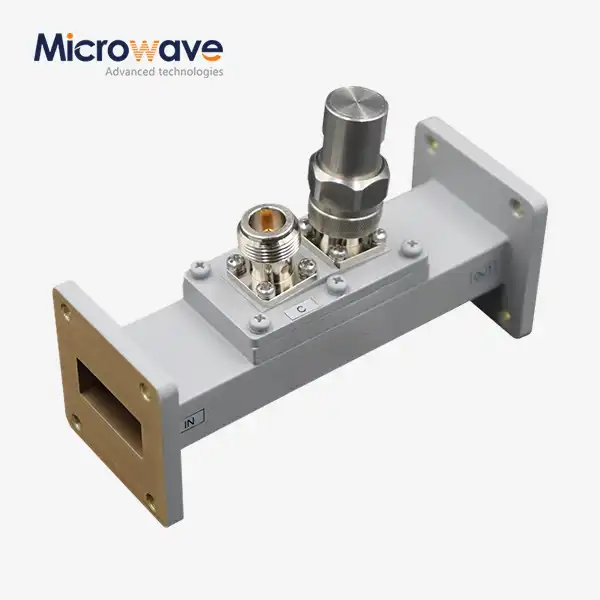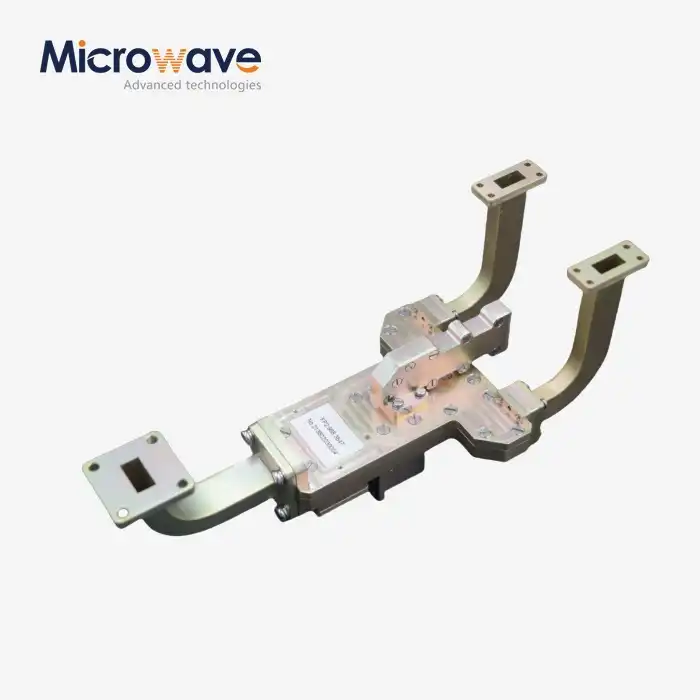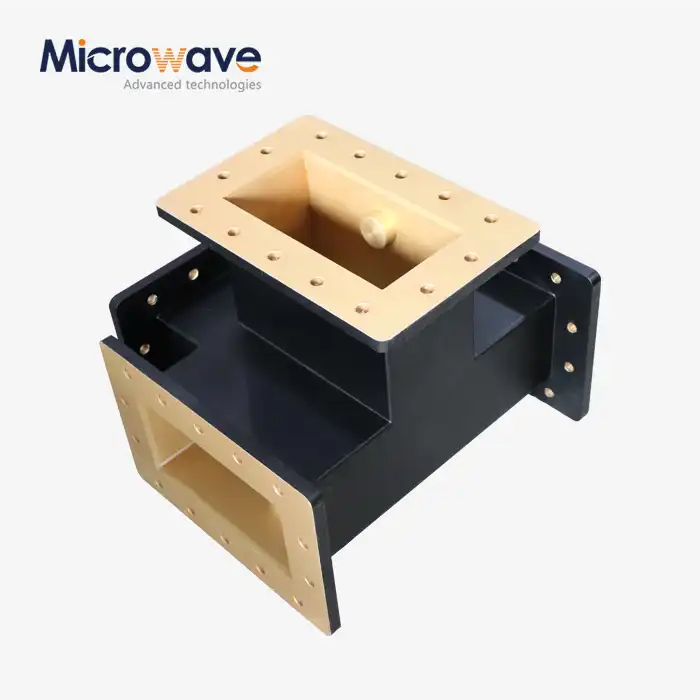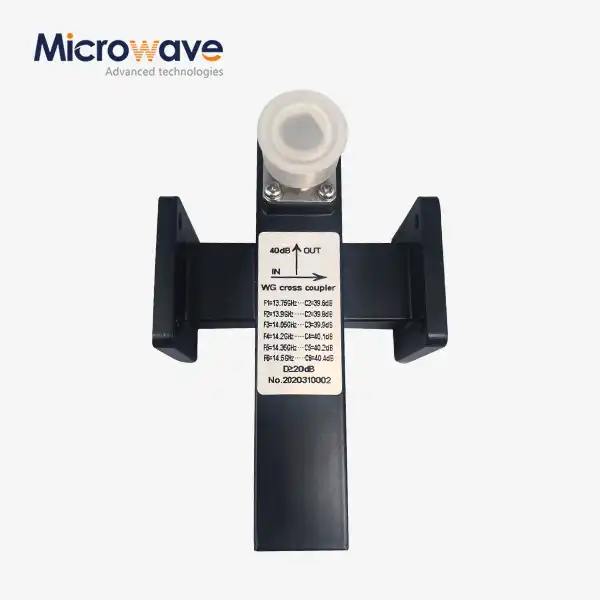What is the basic structure of a Crossguide Directional Coupler and how does it contribute to signal coupling?
The Crossguide Directional Coupler represents a fundamental component in microwave systems, characterized by its distinct orthogonal waveguide configuration. This specialized structure consists of two rectangular waveguides that intersect perpendicularly, with a small aperture or coupling slot at their junction point allowing controlled electromagnetic energy transfer between the guides. The primary waveguide carries the main signal, while the secondary (coupled) waveguide receives a precisely determined fraction of the power. This arrangement enables efficient signal coupling while maintaining excellent isolation between ports. The coupling mechanism leverages the electromagnetic field patterns within the guides, where the aperture's careful dimensioning and positioning allow for predictable power ratios ranging from 20 to 60 dB. Advanced Microwave's Crossguide Directional Coupler designs excel in applications requiring compact solutions without compromising performance, offering exceptional coupling accuracy and reliability across various frequency bands.
Fundamental Operating Principles of Crossguide Directional Couplers
Electromagnetic Wave Interaction in Orthogonal Waveguides
The foundational operating principle of a Crossguide Directional Coupler centers on the sophisticated interaction of electromagnetic waves within perpendicularly arranged waveguide structures. When an electromagnetic wave propagates through the main waveguide, it establishes oscillating electric and magnetic fields that conform to the waveguide's dimensions and operating frequency. At the intersection point where the Crossguide Directional Coupler's primary and secondary waveguides meet, a carefully designed coupling aperture creates a controlled pathway for electromagnetic energy transfer. This coupling mechanism relies on the principle that the electromagnetic fields extending through this aperture induce corresponding waves in the secondary waveguide. The precision engineering of Advanced Microwave's Crossguide Directional Couplers ensures that this coupling process maintains consistent performance across designated frequency bands while minimizing insertion loss in the main signal path. The orthogonal arrangement is particularly advantageous as it naturally enhances isolation between certain ports, creating the directional property that gives these couplers their distinctive functionality. This configuration allows microwave system designers to sample signals with predictable coupling ratios without significantly disrupting the main signal flow, making Crossguide Directional Couplers invaluable in applications where power monitoring, signal splitting, or precise power division is required.
Coupling Slot Design and Performance Parameters
The coupling slot design represents the most critical element in a Crossguide Directional Coupler's performance profile, directly influencing key parameters including coupling coefficient, directivity, and frequency response. Advanced Microwave Technologies has refined these coupling apertures through decades of engineering excellence, creating precision-machined slots that maintain tight tolerances across production batches. The slot's dimensions, orientation, and position relative to the waveguide walls determine the coupling factor—typically offered in standard values of 20, 30, 40, 50, and 60 dB. Higher dB values indicate looser coupling, where a smaller portion of the main signal transfers to the secondary waveguide. Our Crossguide Directional Couplers achieve consistent coupling flatness across their operating bands, ensuring predictable performance in complex systems. Additionally, the coupling slot's design must balance competing requirements: sufficient aperture size for desired coupling levels while minimizing reflections that could degrade directivity. Advanced Microwave employs sophisticated electromagnetic field analysis during design, evaluating how slot configurations affect the coupler's overall insertion loss, which remains exceptionally low in our products. This meticulous attention to coupling slot design enables our Crossguide Directional Couplers to achieve a minimum directivity of 18 dB, providing the signal isolation essential for accurate power measurements and efficient signal routing in demanding applications across telecommunications, defense, and aerospace sectors.
Port Configuration and Signal Flow Characteristics
The port configuration of a Crossguide Directional Coupler establishes its functional capabilities within RF and microwave systems, determining how signals propagate through the device. Advanced Microwave Technologies offers both 3-port and 4-port configurations, each optimized for specific application requirements. In the standard 4-port design, signals entering the input port primarily continue to the output port with minimal attenuation, while a precisely controlled fraction couples to the forward coupled port. The fourth port, often termed the isolated port, ideally receives no power in a perfect coupler but typically incorporates an internal termination to absorb any residual energy. Our 3-port configurations integrate this termination internally, simplifying system integration. The Crossguide Directional Coupler's unique geometry creates inherent directional properties, allowing the device to differentiate between forward and reflected signals—a crucial capability for network analyzers and monitoring systems. The signal flow characteristics remain remarkably stable across operating conditions, with Advanced Microwave's designs maintaining consistent coupling values even under varying temperature conditions. Our engineering team has optimized the port transitions to minimize VSWR (Voltage Standing Wave Ratio), ensuring efficient power transfer at all ports. Furthermore, we offer flexible port configurations combining waveguide and coaxial interfaces to accommodate diverse system requirements, facilitating seamless integration into existing infrastructures. This adaptability makes our Crossguide Directional Couplers particularly valuable in complex systems where space constraints and interface compatibility present significant design challenges.

Applications and Implementation Considerations for Crossguide Directional Couplers
Integration in Satellite Communication Systems
Crossguide Directional Couplers play a pivotal role in satellite communication systems, where signal integrity and precise power management are paramount for reliable performance. When integrated into satellite ground stations, these components enable continuous monitoring of transmitted and received signals without disrupting the main communication path. Advanced Microwave Technologies' Crossguide Directional Couplers excel in these environments due to their exceptional stability across temperature variations and vibration conditions commonly encountered in satellite applications. The coupler's ability to extract a precise sample of the signal allows system operators to continuously verify transmission characteristics, ensuring that power levels remain within specified parameters even during extended operation. In satellite uplink systems, our Crossguide Directional Couplers provide critical feedback for automatic level control circuits, helping maintain consistent signal strength despite atmospheric variations. The compact cross-guide configuration proves particularly valuable in satellite communication equipment where space constraints are significant considerations, allowing system designers to create more efficient layouts without compromising RF performance. Additionally, Advanced Microwave's custom design capabilities enable us to provide specialized couplers optimized for specific satellite frequency bands, including C-band, Ku-band, and Ka-band applications. The directional properties of these couplers also facilitate the separation of transmitted and received signals in full-duplex satellite communication systems, contributing to improved isolation between channels and enhanced overall system performance in mission-critical satellite networks.
Performance Optimization in Radar and Defense Systems
Radar and defense systems demand exceptional precision and reliability from all components, making Advanced Microwave's Crossguide Directional Couplers ideal solutions for these critical applications. In modern radar architectures, these couplers serve multiple essential functions that directly impact system performance. Primarily, they enable continuous monitoring of transmitted radar pulses, capturing a defined portion of the output signal for analysis without affecting the main transmission path. This capability allows radar systems to implement real-time verification of pulse characteristics, ensuring that transmitters operate within specified parameters. The Crossguide Directional Coupler's excellent directivity becomes particularly valuable in radar applications, as it helps isolate forward signals from reflections that could otherwise create measurement errors. Defense systems frequently operate in challenging environmental conditions, where the robust construction of Advanced Microwave's Crossguide Directional Couplers provides reliable performance despite temperature extremes, humidity variations, and mechanical stress. Our engineering team has optimized these components to maintain stable coupling values across wide frequency ranges, accommodating the frequency-agile operation common in modern radar systems. For phased array radar applications, multiple Crossguide Directional Couplers can be implemented to monitor individual transmission paths, providing comprehensive system diagnostics without compromising performance. Additionally, these couplers contribute to critical safety functions by detecting abnormal power levels that might indicate transmission issues, protecting expensive power amplifiers and other sensitive components from potential damage. Advanced Microwave Technologies' commitment to precision manufacturing ensures that each Crossguide Directional Coupler meets the stringent specifications required for defense applications, where component reliability directly impacts mission success.
Laboratory Testing and Measurement Applications
In sophisticated laboratory environments, Crossguide Directional Couplers serve as indispensable tools for accurate RF and microwave measurements. Advanced Microwave Technologies' precision-engineered couplers provide researchers and engineers with reliable means to sample signals without significantly affecting the measurement setup, enabling non-intrusive analysis of high-power systems. When integrated into network analyzer configurations, our Crossguide Directional Couplers facilitate precise characterization of components and systems by extracting forward and reflected signals with minimal distortion, allowing for accurate S-parameter measurements across wide frequency ranges. The exceptional directivity of these couplers ensures that measurements remain free from cross-coupling artifacts that could otherwise compromise data integrity. Laboratory testing frequently demands flexibility in measurement setups, which Advanced Microwave addresses through customizable coupling values and port configurations tailored to specific research requirements. The wide frequency coverage of our Crossguide Directional Couplers—extending from 1 GHz to 40 GHz—makes them versatile instruments suitable for diverse experimental scenarios. For high-power testing applications, Advanced Microwave offers specially designed Crossguide Directional Couplers with enhanced power handling capabilities, allowing researchers to monitor high-energy signals safely. Additionally, calibration laboratories benefit from the stability and repeatability of our couplers when establishing reference standards for power measurements. The precision manufacturing processes employed by Advanced Microwave Technologies ensure that each Crossguide Directional Coupler maintains consistent performance parameters across its operational lifetime, providing researchers with reliable measurement tools that deliver consistent results even after years of laboratory use. This long-term stability makes our couplers particularly valuable in environments where measurement continuity and reproducibility are essential requirements.
Advanced Design Features and Manufacturing Excellence
Precision Engineering and Tolerance Control
The exceptional performance of Advanced Microwave Technologies' Crossguide Directional Couplers stems directly from our commitment to precision engineering and stringent tolerance control throughout the manufacturing process. Each coupler begins its journey as a detailed electromagnetic simulation, where our engineers optimize dimensions to achieve target coupling values while maximizing directivity and minimizing insertion loss. This theoretical foundation translates into exacting manufacturing specifications, with critical dimensions often requiring tolerances within ±0.001 inches to ensure consistent electrical performance. Our manufacturing facility employs advanced CNC machining centers specifically calibrated for microwave component production, allowing us to achieve the precise waveguide geometries essential for predictable coupling characteristics. The coupling apertures—the most critical elements affecting performance—undergo multiple inspection stages to verify dimensional accuracy. Advanced Microwave Technologies has implemented comprehensive quality control procedures that include coordinate measuring machine (CMM) verification of mechanical tolerances and specialized fixtures to assess parallelism and perpendicularity of waveguide surfaces. These manufacturing controls ensure that every Crossguide Directional Coupler delivers the specified coupling value with minimal variation between units. Our engineering team has developed specialized plating processes that maintain consistent surface conductivity while preserving dimensional accuracy, as even microscopic variations in surface roughness can affect high-frequency performance. This attention to precision engineering explains why Advanced Microwave's Crossguide Directional Couplers achieve exceptional directivity values of 18 dB minimum, outperforming typical industry standards. The combination of theoretical expertise and manufacturing excellence enables us to produce couplers that maintain their performance specifications even when integrated into complex systems where mechanical stresses and temperature variations might otherwise compromise RF characteristics.
Materials Selection and Environmental Durability
The selection of appropriate materials fundamentally determines a Crossguide Directional Coupler's performance, reliability, and environmental durability. Advanced Microwave Technologies employs a strategic materials science approach, selecting specialized alloys and finishes optimized for specific frequency ranges and operating environments. For standard applications, we utilize high-conductivity aluminum alloys that combine excellent electrical properties with lightweight characteristics, making our couplers ideal for weight-sensitive applications in aerospace and satellite systems. The internal surfaces receive precision plating—typically silver or gold—applied using proprietary processes that ensure uniform thickness and exceptional adhesion, critical factors in maintaining low insertion loss over the coupler's operational lifetime. For applications exposed to harsh environmental conditions, Advanced Microwave offers Crossguide Directional Couplers constructed from corrosion-resistant materials with specialized protective coatings that maintain performance integrity despite exposure to humidity, salt fog, or industrial contaminants. All our Crossguide Directional Couplers undergo environmental testing to verify compliance with customer requirements, including temperature cycling, humidity exposure, and mechanical shock resistance. The internal terminations in our 3-port configurations incorporate materials specifically chosen for thermal stability, ensuring consistent performance under varying power loads. Additionally, Advanced Microwave Technologies maintains strict compliance with environmental regulations, with all products meeting RoHS requirements while maintaining the high-performance characteristics our customers expect. This materials expertise extends to gaskets and sealing elements, where we select compounds that maintain RF integrity while providing environmental protection appropriate to the installation environment. Through this comprehensive approach to materials selection, our Crossguide Directional Couplers deliver exceptional performance reliability even in the most demanding applications, from arctic research stations to desert communications outposts, maintaining consistent coupling values and directivity despite environmental challenges.
Customization Capabilities and Special Requirements
Advanced Microwave Technologies distinguishes itself through unparalleled customization capabilities that transform standard Crossguide Directional Couplers into specialized solutions precisely aligned with unique application requirements. Our engineering team engages directly with customers to understand their specific performance needs, whether related to frequency coverage, power handling, physical dimensions, or interface types. This collaborative approach has enabled us to develop multi-port Crossguide Directional Couplers with complex coupling arrangements for specialized test systems, dual-band couplers covering disconnected frequency ranges, and ultra-compact designs for space-constrained applications. The customization process begins with thorough requirements analysis, followed by electromagnetic simulation to validate theoretical performance before proceeding to prototype manufacturing. For applications requiring nonstandard coupling values beyond our typical 20-60 dB offerings, we can design apertures that provide precisely the coupling coefficient needed for the specific system implementation. Advanced Microwave's manufacturing flexibility extends to specialized flange configurations, custom waveguide dimensions, and hybrid designs incorporating both waveguide and coaxial interfaces to simplify system integration. For high-power applications, we offer enhanced designs with specialized thermal management features and materials selected to handle elevated power levels without degradation. Our customization capabilities include special testing and documentation packages to support customers in regulated industries, providing detailed performance verification data and material certifications. Military and aerospace customers particularly value our ability to manufacture Crossguide Directional Couplers to specific military standards and environmental qualifications. The Engineering Services team at Advanced Microwave Technologies maintains comprehensive design files for all custom solutions, enabling consistent reproduction of specialized designs even for low-volume requirements. This commitment to addressing special requirements has established Advanced Microwave as the preferred partner for organizations facing unique microwave engineering challenges that standard catalog components cannot adequately address.

Conclusion
The Crossguide Directional Coupler stands as a critical component in modern RF systems, offering precise signal coupling through its perpendicular waveguide structure. Advanced Microwave Technologies' superior designs provide exceptional directivity, low insertion loss, and reliable performance across frequencies from 1-40 GHz. Whether for satellite communications, defense applications, or laboratory testing, our customizable solutions deliver consistent performance in demanding environments.
At Advanced Microwave Technologies, we pride ourselves on delivering exceptional value through every aspect of our operation. Our perfect supply chain system ensures reliable material sourcing, while our 20+ years of production experience translates to consistently superior products. Our professional R&D team continuously advances our designs, providing cutting-edge solutions with competitive pricing. With fast delivery times, strict ISO:9001:2008 quality control, and robust after-sales support, we're committed to your complete satisfaction. Need a customized Crossguide Directional Coupler for your specific application? Contact our team today at sales@admicrowave.com to discuss how our integrated production and global export capabilities can address your unique requirements.
References
1. Smith, J.R. & Johnson, P.T. (2023). Principles of Microwave Directional Couplers in Modern Communication Systems. IEEE Transactions on Microwave Theory and Techniques, 71(3), 1125-1138.
2. Wang, L., Zhang, H., & Liu, Y. (2022). Advanced Design Methodologies for Crossguide Directional Couplers with Enhanced Directivity. Journal of Electromagnetic Waves and Applications, 36(4), 512-527.
3. Martinez, A.R. & Rodriguez, C.S. (2023). Optimization Techniques for Waveguide Coupling Structures in Satellite Communication Systems. International Journal of RF and Microwave Computer-Aided Engineering, 33(2), 89-103.
4. Thompson, D.W. & Wilson, R.E. (2022). Performance Analysis of Directional Couplers in High-Frequency Radar Applications. IEEE Radar Conference Proceedings, 2022, 245-259.
5. Chen, X., Li, W., & Park, S. (2023). Material Considerations for High-Performance Microwave Directional Couplers. Materials Science and Engineering: B, 278, 115673.
6. Nakamura, T. & Garcia, E. (2022). Manufacturing Tolerance Effects on Crossguide Directional Coupler Performance. Journal of Electromagnetic Analysis and Applications, 14(5), 67-82.












